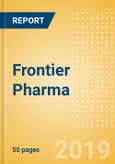Frontier Pharma - Small Cell Lung Cancer: Diverse First-in-Class Pipeline Shows Promise of Targeted Therapies to Treat Aggressive Disease
Summary
Initially considered a curable disease due to substantial sensitivity to chemotherapy, small cell lung cancer (SCLC) remains a fatal disease with a poor outcome, with the majority of patients surviving one year or less after diagnosis. Unlike non-small cell lung cancer (NSCLC), in which major advances in treatment have been made following the approval of numerous targeted therapies, the field of SCLC has seen little advancement, and the standard of care (SOC) for several decades has been platinum-etoposide chemotherapy. Limited tumor tissue for translational research, poor understanding of the mechanisms underlying disease biology, and therapeutic resistance are major factors impeding the discovery of effective drugs, including targeted therapies in SCLC, proving a major clinical need for patients.
To date, there have been three targeted therapies approved to treat SCLC, Bristol-Myers Squibb’s Opdivo (nivolumab), Roche’s Tecentriq (atezolizumab), and Merck & Co.’s Keytruda (pembrolizumab) which were approved by the FDA in August 2018, March 2019 and June 2019, respectively. The recent approval of targeted and immuno-therapies for SCLC will generate a new maintenance setting following chemotherapy in SCLC. Following the approval of these new agents, relapsed/refractory patients are expected to have significantly improved therapeutic options. The increased prescription of branded therapies in treatment-naïve and advanced patients will be the primary impetus driving the substantial growth in the SCLC market.
Scope
Reasons to Buy
Summary
Initially considered a curable disease due to substantial sensitivity to chemotherapy, small cell lung cancer (SCLC) remains a fatal disease with a poor outcome, with the majority of patients surviving one year or less after diagnosis. Unlike non-small cell lung cancer (NSCLC), in which major advances in treatment have been made following the approval of numerous targeted therapies, the field of SCLC has seen little advancement, and the standard of care (SOC) for several decades has been platinum-etoposide chemotherapy. Limited tumor tissue for translational research, poor understanding of the mechanisms underlying disease biology, and therapeutic resistance are major factors impeding the discovery of effective drugs, including targeted therapies in SCLC, proving a major clinical need for patients.
To date, there have been three targeted therapies approved to treat SCLC, Bristol-Myers Squibb’s Opdivo (nivolumab), Roche’s Tecentriq (atezolizumab), and Merck & Co.’s Keytruda (pembrolizumab) which were approved by the FDA in August 2018, March 2019 and June 2019, respectively. The recent approval of targeted and immuno-therapies for SCLC will generate a new maintenance setting following chemotherapy in SCLC. Following the approval of these new agents, relapsed/refractory patients are expected to have significantly improved therapeutic options. The increased prescription of branded therapies in treatment-naïve and advanced patients will be the primary impetus driving the substantial growth in the SCLC market.
Scope
- There are 165 pipeline programs in active development for SCLC. What proportion of these products are first-in-class?
- How does first-in-class innovation vary by development stage and molecular target class?
- Which molecular target classes are prominently represented in the first-in-class SCLC pipeline?
- Which first-in-class targets have been identified as most promising for the treatment of SCLC?
- How does the distribution of target classes differ in terms of development stage?
- Which companies have first-in-class assets in development with no prior deal involvement?
Reasons to Buy
- Understand the current disease landscape with an overview of etiology, pathophysiology, disease classification and staging systems and epidemiology. Visualize the composition of the SCLC market in terms of dominant molecule types and molecular targets.
- Analyze and compare the SCLC pipeline and stratify by stage of development, molecule type, and molecular target.
- Assess the therapeutic potential of first-in-class targets. Using a proprietary matrix, first-in-class programs have been assessed and ranked according to their clinical potential. Promising first-in-class targets have been reviewed in greater detail.
- Recognize commercial opportunities by identifying first-in-class pipeline programs for SCLC that have not yet been involved in licensing or co-development deals, and by analyzing company strategies in prior deals through case studies of key deals for first-in-class SCLC programs.
Table of Contents
1 Table of Contents
2 Small Cell Lung Cancer: Executive Summary
3 Introduction
4 Disease Overview
5 Assessment of Pipeline Product Innovation
6 First-in-Class Molecular Target Evaluation
7 Key Players and Deals
8 Appendix
List of Tables
List of Figures
Samples

LOADING...
Companies Mentioned (Partial List)
A selection of companies mentioned in this report includes, but is not limited to:
- Bristol-Myers Squibb
- Merck & Co.
- Roche








